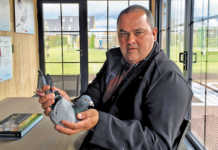
The mare is a seasonal breeder, active only in summer. During spring, when the days start to grow longer, receptors react to this change and activate the oestrous cycle. Your mare may ‘struggle’ a little at the beginning of spring to cycle properly, experiencing heat but no ovulation, this is called ‘transitional oestrus’. But this normally resolves itself within two weeks or so. If it lasts longer you’ll need to call a vet.
The mare’s cycle exists of five stages. Of these you are aiming for one day (only one!) out of 21, when she ultimately ovulates. The best way to know where she is in her cycle is to let her be examined by your vet and simultaneously tease her and closely monitor – and record – her behaviour. You should at this stage therefore have already started teasing (See box).
The mares’ response during this process is rated on a scale from 0 to 4. Scale 4 is very close to ovulation – squatting and urinating a milky stream – and Scale 0 is wanting to kick the teaser. With wild stallions, cover a mare repeatedly when she is in standing heat (Scales 3 and 4) so there are live sperm in her when she ovulates. You’ll have limited semen with AI, so you should be as close to the target time as possible.
Timing
You need to determine if she’s sexually active; if she’s normal (ovaries, uterus) and where she is in her cycle. These factors can be ‘controlled’ by your vet to some extent. But besides a treatment to induce ovulation at a specific time (for AI) other ‘interventions’ are likely to be unnecessary if the mare is cycling normal. When the mare has ovulated (unfertilised) she will go into dioestrus (not showing interest) for the majority of her 21-day cycle – usually 15 days.
She will then be on heat again (Scales 3 and 4) for three to 10 days – most mares average five days. This is the tricky part, as all mares differ. Some are silent ovulaters and don’t even show heat! Here you’ll need a vet’s help. At any rate, on the last of these days on heat, the mare will ovulate.
Do not miss this! Insemination even just a few hours after ovulation will be too late. Your vet should definitely do a rectal exam and preferably a scan as well. Hormone injections may enter the equation now to induce the mare to ovulate, but the follicles should have had enough time to ripen before this can be done.
Communication
If the mare doesn’t get pregnant now she’ll go into dioestrus again. And the whole 21-day cycle will begin again. So if you ‘miss’, don’t worry, you’ll have another chance.Communication with stallion owners is important, as they should know when ovulation is expected, unless you’re using frozen semen. This is so they can have the semen ready to transport and implant.
Most vets will do two AI within a day. This will increase the probability of the mare getting pregnant.
About teasing
Some tips:
- The best is to have enough space for the stallion, or ‘tease’, to stand and sniff the mare without being able to get over to her. A solid wall that’s been padded is ideal. There also needs to be enough space to handle the mare comfortably.
- Know how to monitor and record the mare’s responses. Get some expert advice.
- The teaser should be well-behaved and not hurt the mare. He should be allowed to attempt to mount her while still being protected and controlled.
- He should always approach the mare from the side-front and be allowed to flirt his way to the back. This may only take 30 seconds or up to two minutes. You’ll have to tease the mare twice a day and record the mare’s response. Your vet will want to see this to have a clear idea of what scale the mare’s at.
Contact Kim Dyson on 082 888 6511 or at [email protected]. Please state ‘Horse therapy’ in the subject line of your email.













